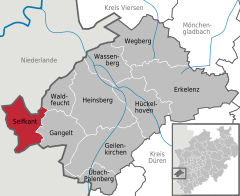Selfkant
| Selfkant | ||
|---|---|---|
| ||
 Selfkant | ||
Location of Selfkant within Heinsberg district 
 | ||
| Coordinates: 51°1′N 5°55′E / 51.017°N 5.917°ECoordinates: 51°1′N 5°55′E / 51.017°N 5.917°E | ||
| Country | Germany | |
| State | North Rhine-Westphalia | |
| Admin. region | Köln | |
| District | Heinsberg | |
| Subdivisions | 16 | |
| Government | ||
| • Mayor | Herbert Corsten | |
| Area | ||
| • Total | 42.08 km2 (16.25 sq mi) | |
| Elevation | 69 m (226 ft) | |
| Population (2012-12-31)[1] | ||
| • Total | 9,916 | |
| • Density | 240/km2 (610/sq mi) | |
| Time zone | CET/CEST (UTC+1/+2) | |
| Postal codes | 52538 | |
| Dialling codes |
02456 02455 (Saeffelen) | |
| Vehicle registration | HS | |
| Website | www.selfkant.de | |

Selfkant (German pronunciation: [ˈzɛlfkant]) (Dutch: Selfkant (Dutch pronunciation: [ˈzɛɫfkɑnt]) or Zelfkant) is a municipality in the Heinsberg district, in North Rhine-Westphalia, Germany. It is the most westerly municipality in Germany since 1919 — before, the title was held by Gravelotte in Alsace-Lorraine. Its border with the Netherlands is 27 kilometres long, while the border with the rest of Germany is only 6 kilometres long.
History
The most important domain in Selfkant in the Middle Ages was the castle and village of Millen, the residence of the lords of Millen, which became part of the domain Heinsberg in 1282. In 1499 these were joined by the duke of Jülich and Millen became the seat of an Amtmann. The places Tüddern, Wehr, Süsterseel and Hillensberg belonged to the Amt Born and after 1709 to the Amt Sittard.
From 1794 to 1815 Selfkant was part of the French canton Sittard (department of the Roer). After the Congress of Vienna it became part of the Prussian Rhine province. The border with the Netherlands which was then fixed continued to exist until shortly after the Second World War.
Tüddern
After the Second World War, on 23 April 1949, the Netherlands annexed Selfkant as part of war reparations, and its inhabitants were given a Dutch passport with the special indication "to be treated as a Dutchman". The Dutch government appointed a country landdrost to head the governing board of the Tüddern 'office', as the Selfkant was renamed for administrative purposes. The governing board appointed by the Germans was sent home because it was contrary to the Dutch constitution. However as a transitional measure for ex-German territories, the German governing board retained an advisory role.
At that time much was invested in such things as houses and roads. Parts of the area became Dutchified, and the Dutch influence is still present.
In the Dutch period, the N274 road was built to provide a direct link between Roermond and Heerlen. Even after 1963 the road remained a narrow strip or corridor of Dutch territory with no junctions with German roads, and no passport was needed to use it. On 25 February 2002 the road was returned to Germany and in the course of 2004 connections were made with several roads, among others with the B56 between Gangelt and Süsterseel.
German municipality
In March 1957 official negotiations started between the Netherlands and West Germany concerning the return of the area, and on 1 August 1963 the area was returned to Germany in exchange for a payment of 280 million deutschemarks. From the existing 'office' of Tüddern the old municipalities of Havert, Hillensberg, Höngen, Millen, Süsterseel, Tüddern and Wehr were formed. Two months later, on 21 October 1963, the first municipal council elections under German authority were held.
The seven municipalities, with the municipality of Saeffelen from the Amt Waldfeucht, were added to the municipality Selfkant on 1 July 1969.
With 233 inhabitants per km² Selfkant is considered a rural municipality. Because of the favourable price of land the municipality is nowadays very much in demand with young families. A lot of Dutch cross the border to build their own houses there. Roughly one quarter to one half of the inhabitants are Dutch. At the mayoral election of 2003 a Dutch inhabitant put himself forward as candidate.
Many residents are also stationed, work, or are family members of employees at the NATO Air Base in Geilenkirchen. Tüddern alone has over 30 American families with the Gem. Selkant having dozens more. Many Canadians at the NATO base also live in Selfkant. English is quite prominent as a third language to Dutch and German in the whole area.
Gallery
-
Saeffelen, church: Pfarrkirche Sankt Lucia
-
Höngen, chapel (Sankt Lambertuskapelle) in the street
-
Tüddern, church
-
Millen, church: Propsteilkirche Sankt Nikolaus
| Wikimedia Commons has media related to Selfkant. |
| |||||||
References
- ↑ "Amtliche Bevölkerungszahlen". Landesbetrieb Information und Technik NRW (in German). 31 July 2013.




